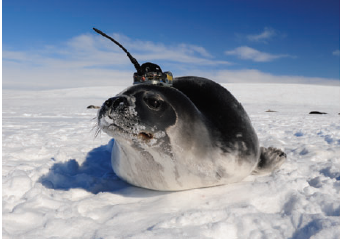Open Ocean Migrations and Their Implications for Conservation
By Dani Escontrela, RJD Intern
Over time our understanding of animal migrations and habitats has greatly increased due to advances in tracking technology. Whereas before tags only told us when animals arrived and left certain places, tracks now are able to tell us about the migratory paths they follow. In addition other methods such as ship and plane surveys where limited to where we looked, however with tagged animals we can look were we hadn’t before. Marine animals have developed the ability to move across large ocean expanses, this is due to the fact that many times food resources and breeding sites may be separated by hundreds of kilometers. By understanding what drives these migrations, their seasonality and the paths they take we can help in the conservation and management of many species.

The image shows the distribution of Elephant Seals using ship and plane surveys. b) This image shows the distribution of female elephant seals determined through satellite tracking technology. As we can see, tagging technology has aided in the further understanding of animal’s migration patterns by helping us look were we hadn’t before.
Recent tags are small, so they don’t interfere with animals’ natural behavior, and robust, so they can withstand the marine environment. Some of the more used technologies today are archival tags, Argos satellite tags, GPS tags and acoustic tracking. While these technologies have become better over the years, some of them still face some limitations as to what they are capable of doing. The new tags in combination with models and new analysis methods have allowed us to understand the migrations to a better extent.

The tags are relatively small, very robust and are capable of providing oceanographic data. Here a Weddell seal wears a Sea Mammal Research Unit conductivity-temperature-depth tag in Antarctica
Something that has remained highly elusive however, is the mechanisms by which animals are able to perform these long distance migrations. In places that are devoid of environmental cues, animals are still able to make their way to specific sites. They obviously rely on well-developed navigation abilities to migrate. Two cues that have been explored are celestial and geomagnetic cues, although further field experiments remain to be done to prove these are the mechanisms the animals use.
In addition to tracking animals’ movements, these tags have also aided in oceanographic studies providing us with more data where conventional methods may be limited or absent. Tags are able to measure everything from temperature to salinity and light, among other things. All this new data provided by the tags is being made available to the oceanographic community through databases that usually only provided ship based data.
All this information about migrations used to be important to fisheries and hunters so they could make greater catches; however, management and conservation rely on this information today in order to protect many species. Information such as movement patterns and where they perform vital activities is crucial for management plans, such as the creation of Marine Protected Areas.
Although the technology has greatly improved, many advances still have to be made to the tags such as increasing sensor capabilities, finding other ways to power the tags, better attachment methods, etc. Another major advancement would be if data obtained by the tags could be transmitted underwater. Although the tags have provided us with a view of the migration patterns of many animals, we must also know how these migrations are made and what’s desirable about the sites traveled to; when we know this, we will be able to create better management plans. Long distance continuous migrants need to be targeted for controlled field based manipulations in order to better study the mechanisms of these migrations. The new technologies made available today will aid in performing these field experiments and understanding the mechanisms by which migrations are made and the habitats that these animals travel to.
REFERENCE
Daniel P. Costa, Greg A. Breed, and Patrick W. Robinson (2012) New Insights into Pelagic Migrations: Implications for Ecology and Conservation. Trends in Ecology and Evolution




Leave a Reply
Want to join the discussion?Feel free to contribute!